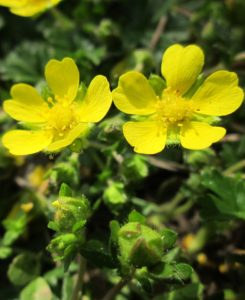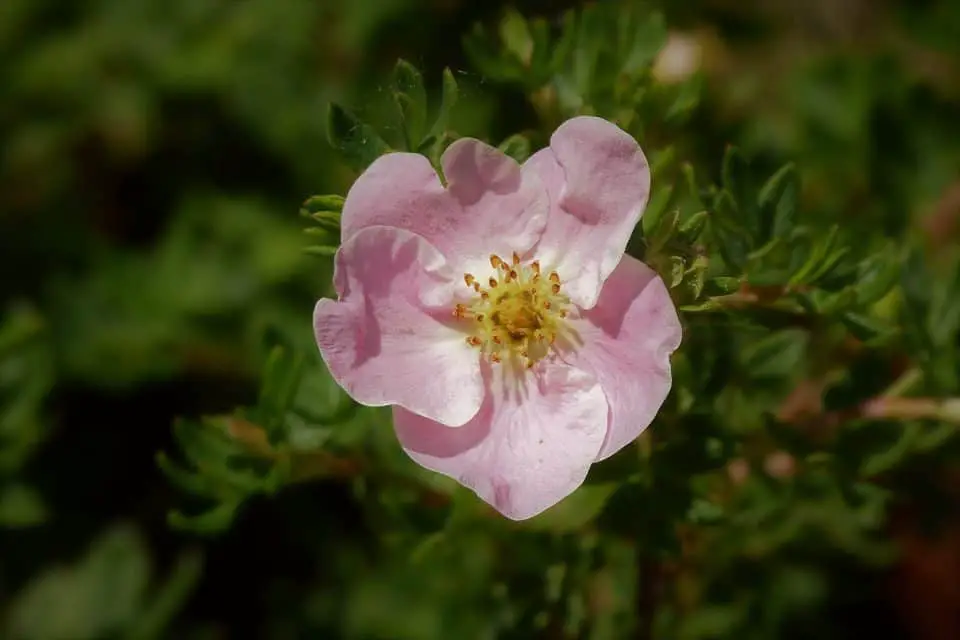Some links in the post are affiliate links and I get a commission from purchases made through some links found in the post.
For any of us who feel we really do not have ‘green fingers and thumbs’ this is a plant to reassure you that anyone can grow things! This is one of the lowest maintenance shrubs you will find.
Once it is established, the potentilla literally needs no further attention that to prune it to the size you fancy.
Even with pruning, you never need any special skills as an ‘all over haircut’ will do just fine!
If you have recently moved into a house with an overgrown garden – and are lucky enough to find a potentilla – simply chop it back and wait for next year.
Potentilla is also known as Cinquefoil. It is classed as a shrub and is grown for its long-lasting blossoms.
Young plants grow quickly although as they get older the growth slows down. They make ideal additions to a sunny corner of the garden where they will happily grow and blossom year after year.
How and When to Prune Potentilla
 If you have inherited potentilla and see that it is not flowering well, then you can liven the shrub up by pruning all the stems back in the spring.
If you have inherited potentilla and see that it is not flowering well, then you can liven the shrub up by pruning all the stems back in the spring.
Chop back as close to the ground as you can. Bear in mind that the shrub will not flower in the next summer but will reward you the following year with a mountain of blooms.
Ideally you should prune your potentilla and get rid of dead stems whenever you see them.
The easiest way to check if a stem is dead is to lightly scratch the bark with a fingernail. It you see green below, then the stem is not dead, and you can leave it alone.
Make sure you prune the stems back to just above a bud or lateral branch. You should also cut back any damaged branches which may have been caused by heavy winds etc.
If you feel you need to control the height of the shrub then you can out the highest stems at ground level. Try to remove any stems which look out of place. You can prune for the height every year if you need to.
How Tall Does Potentilla Grow?
The average potentilla will grow to a height of between 1 – 3 feet. It should have a spread of almost the same measurement.
The potentilla enjoys growing anywhere as long as the soil is not too wet. They prefer full sunlight and will reward you with blooms ranging from white, pink, orange, and red.
How to Grow a Potentilla Shrub
You should easily be able to buy shrubs from your local garden centre. To plant them, be sure to place them about 3 – 6 feet apart, because they will spread as they become established.
Once you have planted your shrubs, water them well and use a mulch of wood chips or back to keep the soil around them moist. This will also stop weeds from taking root.
It is a good idea to feed the plants in spring with a mixture of compost and organic plant foods.
Note: In very cold areas you will see some dieback as the temperature drops. Prune all dead branches in the spring and shape as you wish. You will not hurt your potentilla by cutting back severely.
Try not to plant your potentilla in dry/hot conditions as this promotes spider mites. If this is an issue, then you can use an insecticidal spray to wash them away.
Different Types of Potentilla Shrubs
Because there are different types of this versatile shrub, you will be able to find one to match any other plants in your garden. Any one of these plants will enhance a patio or a flower bed.
- Abbotswood – this shrub produces single white flowers. The leaves are a blue/green.
- Sunset – this plant has orange blooms which fade to yellow as the temperatures rise.
- Uman – this plant will produce the most beautiful bicoloured blooms of red and orange.
- Primrose Bounty – the blooms of this type are soft yellow with very attractive silvery leaves.
- Medicine Wheel Mountain – the blooms of this type are different because they are yellow and ruffled.
Can you Prune Potentilla in the Fall?
Yes, you can prune your potentilla in the fall. You can prune it close to the ground to reshape it. You will soon notice that new shoots appear.
However, you may find that the shrub does not flower as well in the first year after a hard prune, but the following year will deliver heaps of blossoms.
If you plan to prune in the fall, then September is an ideal month to do this.
If you’re enjoying this article, check out our article on what is the difference between pruners and secateurs.
Can you Prune Potentilla in Spring?
Yes you can prune your potentilla in spring although they can be pruned at any time of the year, ideally September is the best time to do this if you want a show of blooms the following year.
Is Potentilla Poisonous to Dogs?
Having pets in the garden always raises the question about plants which are harmful to animals, and for anyone who has dogs, it can be a nightmare because dogs – and cats – are curious creatures and will unwittingly harm themselves with poisonous plants.
The great thing about potentilla is that it is not poisonous to either dogs or cats. Neither is it harmful for horses.
What Can we Plant with Potentilla?
 Because potentilla is such a versatile shrub there are many places where it will look beautiful and compliment other plants.
Because potentilla is such a versatile shrub there are many places where it will look beautiful and compliment other plants.
Potentilla grows very well under windows or mixed into the flower border. If you have the yellow flowering variety, then you may want to pair this with a blue baptisia or a salvia.
Any red flowering shrubs or annuals will enhance the yellow of the potentilla, purple pansies will add to the colour, as will petunias which come in several different colours.
California Poppy will always look good next to potentilla, as does any of the hardy hibiscus family.
Mexican daisy, oriental poppy, and potentilla will enhance each other, as will any roses, or even a bush of Lavender.
Why is my Potentilla Dying?
There are several reasons why your potentilla may appear to be dying, so let’s look at them.
Stress after Planting
Although this is a hardy plant, you should take care when first planting it as it can quite easily become stressed.
Under and overwatering, over fertilizing and even accidental contact with chemicals can cause your potentilla to have an adverse reaction and appear to die.
If you need help watering your plant, try using this automatic drip irrigation kit.
Planting When too Hot or Cold
This is a common cause of death for newly planted shrubs. You simply cannot buy your plant from the garden centre and shove it in the ground. If the temperatures are too high or too low your plant needs to be hardened off first.
Gradually introduce your shrub to the outside temperatures before you actually pop it in the ground.
Changing from Pot to Ground
You may have kept your potted shrubs in sheltered places – who wants their pots to blow over?
So, when you want to transplant to the ground and decide that your potentilla is going to have a home in a certain corner, make sure that the conditions are not the opposite of where it was in its pot.
Too Much Fertiliser too Soon
Transplanting your potentilla will leave it stressed, like most other plants. It is a stressful thing which may cause a plant to go into shock.
In fact, most plants when transplanted will react and go into shock. Some of them will fare better than others, but transplanting plants will cause stress.
Try to keep things as similar as possible and – more importantly – after you have transplanted it, do not fertilize right away. A plant which is in shock cannot use the nutrients while it is in shock, this will most likely cause your plant to die.
Check for Caterpillars
This is one of the few pests that the potentilla is susceptible to. Luckily you can easily see them and pick them off.
Check Drainage if in a Pot
Your potentilla will not enjoy having his feet too wet. Neither will it appreciate soil in the pot being too dry.
Make sure that when you water you give a good soaking, and check that the pot has adequate drainage so excess water can soak away.
Final Thoughts
 Fortunately, the potentilla shrub is extremely hardy and even if it looks as if it is unhealthy, you can most likely salvage it by pruning it back quite heavily.
Fortunately, the potentilla shrub is extremely hardy and even if it looks as if it is unhealthy, you can most likely salvage it by pruning it back quite heavily.
You will lose the majority of the blooms in the following season, but the plant will reward you with a spectacular display after that.
Knowing how and when to plant your potentilla will give you a head start to the flowering season.
This is a hardy plant which requires the minimum amount of maintenance and gives you the greatest return in the way of beautiful flowers in several different colours.
With shrubs that are so low maintenance and beautiful as well, there is no reason why even a beginner gardener cannot have a spectacular display of colour in the garden, or even on the patio, every summer.
Before you go, here are some more related articles I encourage you to read below to help solve more of your gardening issues:
What to plant with coleus in a container.
What Flowers Only Bloom Once a Year & Once Every 100 Years
Is Celosia Dragon’s Breath an Annual or Perennial


